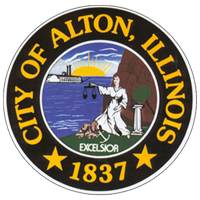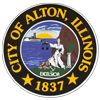DESCRIPTION OF STORMWATER MAINTENANCE
Alton Collection System consists of sanitary, storm, and combined sewers. There are 205 miles of main lines, 3,680 manholes, 1,026 catch basins, 858 inlets, and 13 pump stations.
PERMIT FEES
The lateral Inspection Fee is $25.00 for a residential inspection and $50.00 for a commercial inspection.
STORMWATER POLLUTION PREVENTION
As stormwater flows over driveways, lawns, and sidewalks it picks up debris, chemicals, dirt, and other pollutants. Stormwater can flow into a storm sewer system or directly to a lake, stream, river, or wetland. Anything that enters a storm sewer system is discharged untreated into the waterbodies we use for swimming, fishing, and providing drinking water. Polluted runoff is the nation’s greatest threat to clean water.
By practicing healthy household habits, homeowners can keep common pollutants like pesticides, pet waste, grass clippings, and automotive fluids off the ground and out of stormwater. Adopt these healthy household habits and help protect lakes, streams, rivers, wetlands, and coastal waters. Remember to share the habits with your neighbors!
What is stormwater runoff?
Stormwater runoff occurs when precipitation from rain or snowmelt flows over the ground. Impervious surfaces like driveways, sidewalks, and streets prevent stormwater from naturally soaking into the ground.
Why is stormwater runoff a problem?
Stormwater can pick up debris, chemicals, dirt, and other pollutants and flow into a storm sewer system or directly to a lake, stream, river, or wetland. Anything that enters a storm sewer system is discharged untreated into the waterbodies we use for swimming, fishing, and providing drinking water.
STORMWATER POLLUTION SOLUTIONS
Lawn Care
- Excess fertilizers and pesticides applied to lawns and gardens wash off and pollute streams. In addition, yard clippings, and leaves can wash into storm debris and contribute nutrients and organic matter to streams.
- Don’t overwater your lawn. Consider using a soaker hose instead of a sprinkler.
- Use pesticides and fertilizers sparingly. When use is necessary use these chemicals in the recommended amounts. Use organic mulch or safer pest control methods whenever possible.
- Compost or mulch yard waste. Don’t leave it in the street or sweep it into storm drains or streams.
- Cover piles of dirt or mulch being used in landscaping projects.
Septic Systems
- Leaking and poorly maintained septic systems release nutrients and pathogens (bacteria and viruses) that can be picked up by stormwater and discharged into nearby water bodies. Pathogens can cause public health problems and environmental concerns.
- Inspect your system every 3 years and pump your tank as necessary (every 3 – 5 years).
- Don’t dispose of household hazardous waste in sinks or toilets.
Swimming Pool and Spa
- Drain your swimming pool only when a test kit does not detect chlorine levels.
- Properly store pool and spa chemicals to prevent leaks and spills, preferably in a covered area to avoid exposure to stormwater.
Auto Care
- Washing your car and degreasing auto parts at home can send detergents and other contaminants through the storm sewer system. Dumping automotive fluid into storm drains has the same result as dumping the materials directly into a water body.
- Use a commercial car wash that treats or recycles its wastewater or wash your car in your yard so the water infiltrates into the ground.
- Repair leaks and dispose of auto fluids and batteries at designated drop-off or recycling locations.
Pet Waste
- Pet waste can be a major source of bacteria and excess nutrients in local waters.
- When walking your pet, remember to pick up the waste and dispose of it properly. Flushing pet waste is the best disposal method. Leaving pet waste on the ground increases public health risks by allowing harmful bacteria and nutrients to wash into the storm drain and eventually into local water bodies.
Commercial
- Dirt, oil, and debris that collect in parking lots and paved areas can be washed into the storm sewer system and eventually enter local water bodies.
- Sweep up litter and debris from sidewalks, driveways, and parking lots, especially around storm drains.
- Cover grease storage and dumpsters and keep them clean to avoid leaks.
- Report any chemical spill to the local hazardous waste cleanup team. They’ll know the best way to keep spills from harming the environment.
Construction
- Erosion controls that aren’t maintained can cause excessive amounts of sediment and debris to be carried into the stormwater and deposited into local water bodies.
- Divert stormwater away from disturbed or exposed areas of the construction site.
- Install silt fences, vehicle mud removal areas, vegetative cover, and other sediment and erosion controls and properly maintain them, especially after rainstorms.
- Prevent soil erosion by minimizing disturbed areas during construction projects, and seed and mulch bare areas as soon as possible.
Ten Things You Can Do to Prevent Stormwater Runoff Pollution
1. Use fertilizers sparingly and sweep up driveways, sidewalks, and roads.
2. Never dump anything down storm drains.
3. Vegetate bare spots in your yards.
4. Compost your yard waste.
5. Avoid pesticides; learn about Integrated Pest Management (PM).
6. Direct downspouts away from paved surfaces.
7. Take your car to the car wash instead of washing it in the driveway.
8. Check the car for leaks, and recycle motor oil.
9. Pick up after your pet.
10. Have your septic tank pumped and system inspected regularly.
Stormwater Brochures
- Green Stormwater Brochure
- Kids Stormwater Brochure
- Business Stormwater Brochure
- Resident Stormwater Brochure
Stormwater Hotline, 618.296.7788

